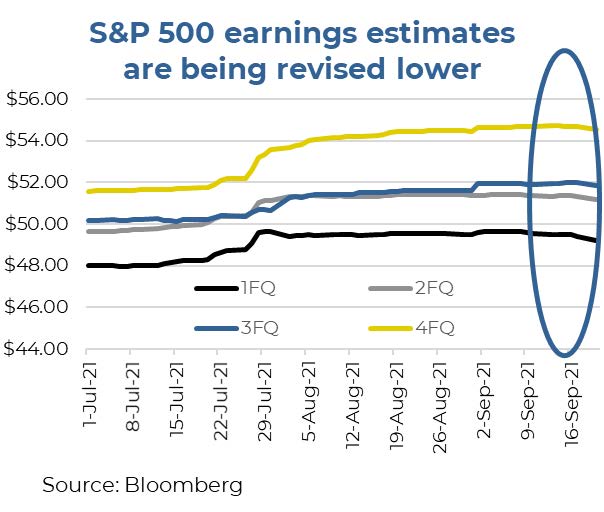The life blood of the equity market is the earnings generated by the companies in the index. Sometimes the market pays more for these earnings, like these days, sometimes less.
For instance over the past decade, the Price-to-earnings (PE or market multiple) for the S&P 500 has ranged from 10.3 to 23.2 with the current level at 21.1. This is based on forward 12-month consensus estimates for earnings. Canada’s TSX has a similar range, 10.8 to 20.8, although its current PE ratio at 16x is not in the upper range. Attempting to understand how much the market will pay or value $1 of earnings clearly changes and sometimes it changes fast.
The market multiple is influenced by many factors. Yields in the bond market have an influence given this is a competing asset class to equities. Historically, higher yields have coincided with a lower PE ratio for the equity market. I mean if you are going to receive say a guaranteed 5% coupon from bonds, you won’t pay as much for a $1 of earnings given all the added uncertainties with equities. These days with low yields, equity PE ratios tend to be higher. However, the biggest driver of the market multiple is the outlook. If the economy is doing well, with few clouds on the horizon, the PE ratio tends to be higher. When uncertainty about the future path of the economy rises, investors won’t pay as much for earnings as the future path becomes less certain.
In 2019 and 2020, market returns were predominantly driven by multiple expansion. Yes, even through that quick bear market, which saw a rapid multiple compression only to be followed by an even more incredible multiple expansion. The chart above decomposes the annual returns for the S&P 500 and TSX comprised of dividends, earnings growth and change in the multiple. The red bars are changes in the market multiple, by far the biggest driver of index performance in the past two years. Please note, while earnings and dividends grow over time, the market multiple does not grow, it is a zero sum game. In other words multiple expansions are offset by multiple contractions in other years.
We have started to see some multiple contraction after a few years of expansion in 2021. The good news is earnings growth came to the market’s rescue, big time. The forward 12-month consensus earnings for the S&P 500 was $166 at the start of 2021, it is now $214 for the next 12-months. Earnings initially were just rebounding off depressed levels but over the past few quarters it has been the stronger than anticipated economic recovery that has driven estimates even higher. And rising earnings cure or sooth many market ailments. Higher yields, Fed tapering, China real estate issues, if there is enough earnings growth the market won’t care nearly as much.
Oh oh
So why are we going on about earnings? Earnings growth, or more accurately rising earnings forward estimates have driven market returns in 2021 (big mellow yellow bars in the previous chart). Re-opening economies, higher commodity prices, surprisingly robust demand growth focused on durables over services created the perfect elixir for S&P & TSX earnings. A 29% rise in forward earnings from nine months ago is the fastest pace we have seen in a long time. TSX at 24% is no slouch either. BUT, over the past few weeks we have started to see earnings estimates begin to fall. Don’t get too alarmed, this isn’t earnings growth turning negative, estimates are just falling. Currently, the S&P 500 is expected to earn $198.62 for 2021 (2 quarters in the bag, 2 to go). And next year bottom up consensus estimates are for $218.03. Clearly positive, albeit a slower pace of earnings growth (+10%).
These estimates have started to decline, reversing a trend in rising estimate revisions that had been the trend. For the past year the trend in estimate forecasts has been in the upward direction. But in mid August this trend stalled and September has witnessed analysts revising their earnings forecasts lower (chart below). Still a subtle decline, but the new direction is not encouraging.
Some slowing of the momentum in economic growth is one factor. However, another is rising costs. Last week saw Fedex Corp, often a bellwether for economic activity, highlight that while demand and pricing remains healthy, costs are now rising faster and offsetting the good news. Shares fell 8% on the news.
Some slowing of the momentum in economic growth is one factor. However, another is rising costs. Last week saw Fedex Corp, often a bellwether for economic activity, highlight that while demand and pricing remains healthy, costs are now rising faster and offsetting the good news. Shares fell 8% on the news.
Digging deeper into Q3 earnings, which will start to be reported early in October, the negative revisions appear most prevalent in a few sectors. Consumer Discretionary has taken the brunt of the revisions. Couple factors contributing to this including autos, which are experiencing supply chain disruptions. Plus, as the economy re-opens and consumers begin spending more on services, a side effect of this is spending less on durables (a big component of Consumer Discretionary). Industrials have seen the 2nd largest decline in estimates and this will likely expand as analysts update their forecasts from the Fedex lowering of guidance.
There is a silver lining to these U.S. trends in sector earnings revisions for Q3. The TSX, given its heavier weighting in Energy, Materials and Financials should be less impacted. Assuming the sector trends are evident across the border. And in fact this is what the numbers show as well. Estimate revisions for the TSX Q3 earnings season have not seen the negative revision pace as the U.S. market. Go Canada.
Investment Implications
Earnings growth and positive revisions have helped equity markets move higher over the past year. Unfortunately, that positive impulse appears to be fading. While the negative revisions are minor so far and there is still positive earnings growth, this coming Q3 earnings season may not be a cake walk. The past earnings season have witnessed much higher than normal positive surprise rate in terms of the frequency of companies exceeding estimates and the magnitude of those ‘beats’. As costs continue to rise and the pace of top line sales growth slows, companies better able to control costs and/or pass costs onto customers should fair better.
Added consideration should be given to holdings or exposure to Consumer Discretionary, Industrials and Consumer Staples. Estimates in these sectors are being revised lower for good reason. Having less exposure or tilting towards more defensive holdings in these sectors may prove prudent as we begin to navigate through more challenging earnings seasons.
Charts are sourced to Bloomberg L.P. unless otherwise noted.
The contents of this publication were researched, written and produced by Purpose Investments Inc. and are used by Echelon Wealth Partners Inc. for information purposes only.
This report is authored by Craig Basinger, Chief Market Strategist, Purpose Investments Inc.
Forward Looking Statements
Forward-looking statements are based on current expectations, estimates, forecasts and projections based on beliefs and assumptions made by author. These statements involve risks and uncertainties and are not guarantees of future performance or results and no assurance can be given that these estimates and expectations will prove to have been correct, and actual outcomes and results may differ materially from what is expressed, implied or projected in such forward-looking statements.
The opinions expressed in this report are the opinions of the author and readers should not assume they reflect the opinions or recommendations of Echelon Wealth Partners Inc. or its affiliates. Assumptions, opinions and estimates constitute the author’s judgment as of the date of this material and are subject to change without notice. We do not warrant the completeness or accuracy of this material, and it should not be relied upon as such. Before acting on any recommendation, you should consider whether it is suitable for your particular circumstances and, if necessary, seek professional advice. Past performance is not indicative of future results. These estimates and expectations involve risks and uncertainties and are not guarantees of future performance or results and no assurance can be given that these estimates and expectations will prove to have been correct, and actual outcomes and results may differ materially from what is expressed, implied or projected in such forward-looking statements.
The particulars contained herein were obtained from sources which we believe are reliable, but are not guaranteed by us and may be incomplete. The information contained has not been approved by and are not those of Echelon Wealth Partners Inc. (“Echelon”), its subsidiaries, affiliates, or divisions including but not limited to Chevron Wealth Preservation Inc. This is not an official publication or research report of Echelon, the author is not an Echelon research analyst and this is not to be used as a solicitation in a jurisdiction where this Echelon representative is not registered.
The opinions expressed in this report are the opinions of its author, Richardson Wealth Limited (“Richardson”), used under a non-exclusive license and readers should not assume they reflect the opinions or recommendations of Echelon Wealth Partners Inc. (“Echelon”) or its affiliates.
This is not an official publication or research report of Echelon, the author is not an Echelon research analyst and this is not to be used as a solicitation in a jurisdiction where this Echelon representative is not registered. The information contained has not been approved by and are not those of Echelon, its subsidiaries, affiliates, or divisions including but not limited to Chevron Wealth Preservation Inc. The particulars contained herein were obtained from sources which we believe are reliable, but are not guaranteed by us and may be incomplete.
Assumptions, opinions and estimates constitute the author’s judgment as of the date of this material and are subject to change without notice. Echelon and Richardson do not warrant the completeness or accuracy of this material, and it should not be relied upon as such. Before acting on any recommendation, you should consider whether it is suitable for your particular circumstances and, if necessary, seek professional advice. Past performance is not indicative of future results. These estimates and expectations involve risks and uncertainties and are not guarantees of future performance or results and no assurance can be given that these estimates and expectations will prove to have been correct, and actual outcomes and results may differ materially from what is expressed, implied or projected in such forward-looking statements.
Forward-looking statements are based on current expectations, estimates, forecasts and projections based on beliefs and assumptions made by author. These statements involve risks and uncertainties and are not guarantees of future performance or results and no assurance can be given that these estimates and expectations will prove to have been correct, and actual outcomes and results may differ materially from what is expressed, implied or projected in such forward-looking statements.


















